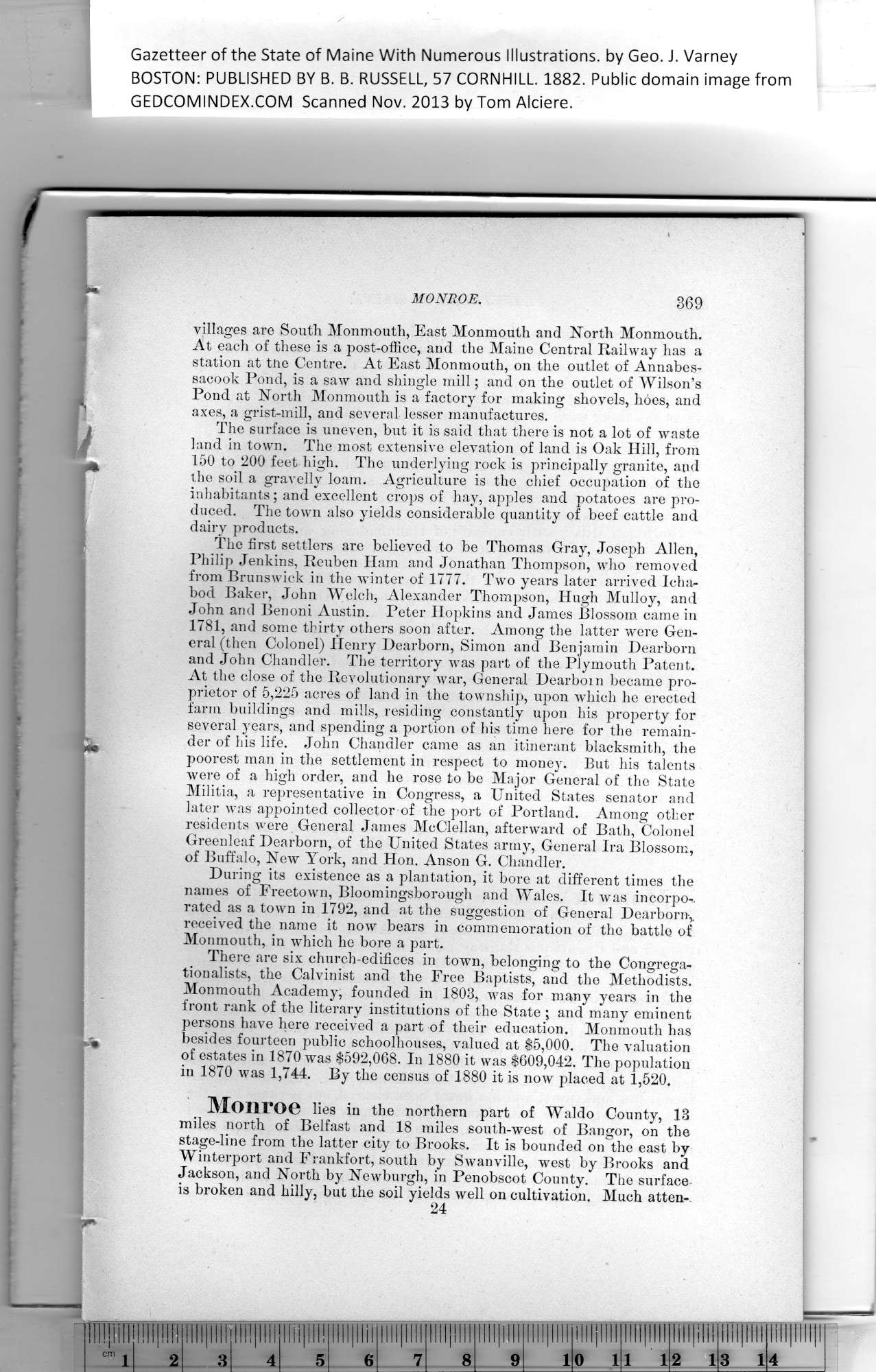|
Gazetteer of the State of Maine With Numerous Illustrations, by Geo. J. Varney
BOSTON: PUBLISHED BY B. B. RUSSELL, 57 CORNHILL. 1882. Public domain image from
MONROE. 369
villages are South Monmouth, East Monmouth and North Monmouth.
At each of these is a post-office, and the Maine Central Railway has a
station at tne Centre. At East Monmouth, on the outlet of Annabes-
sacook Pond, is a saw and shingle mill; and on the outlet of Wilson’s
Pond at North Monmouth is a factory for making shovels, hoes, and
axes, a grist-mill, and several lesser manufactures.
The surface is uneven, but it is said that there is not a lot of waste
land in town. The most extensive elevation of land is Oak Hill, from
150 to 200 feet high. The underlying rock is principally granite, and
the soil a gravelly loam. Agriculture is the chief occupation of the
inhabitants; and excellent crops of hay, apples and potatoes are pro-
duced. The town also yields considerable quantity of beef cattle and
dairy products.
The first settlers are believed to be Thomas Gray, Joseph Allen,
Philip Jenkins, Reuben Ham and Jonathan Thompson, who removed
from Brunswick in the winter of 1777. Two years later arrived Icha-
hod Baker, John Welch, Alexander Thompson, Hugh Mulloy, and
John and Benoni Austin. Peter Hopkins and James Blossom came in
1781, and some thirty others soon after. Among the latter were Gen-
eral (then Colonel) Henry Dearborn, Simon and Benjamin Dearborn
and John Chandler. The territory was part of the Plymouth Patent.
At the close of the Revolutionary war, General Dearborn became pro-
prietor of 5,225 acres of land in the township, uj)on which he erected
farm buildings and mills, residing constantly upon his property for
several years, and spending a portion of his time here for the remain-
der of his life. John Chandler came as an itinerant blacksmith, the
poorest man in the settlement in respect to money. But his taleuts
were of a high order, and he rose to be Major General of the State
Militia, a representative in Congress, a United States senator and
later was appointed collector of the port of Portland. Among other
residents were General James McClellan, afterward of Bath, Colonel
Greenleaf Dearborn, of the United States army, General Ira Blossom,
of Buffalo, New York, and Hon. Anson C. Chandler.
During its existence as a plantation, it bore at different times the
names of Freetown, Bloomingsborough and Wales. It was incorpo--
rated as a town in 1792, and at the suggestion of General Dearborn-,,
received the^ name it now bears in commemoration of the battle of
Monmouth, in which he bore a part.
There are six church-edifices in town, belonging to the Congrega-
tionalists, the Calvinist and the Free Baptists, and the Methodists.
Monmouth Academy, founded in 1803, was for many years in the
front rank of the literary institutions of the State ; and many eminent
persons have here received a part of their education. Monmouth has
besides fourteen public schoolhouses, valued at $5,000. The valuation
of estates in 1870 was $592,068. In 1880 it was $609,042. The population
in 1870 was 1,744. By the census of 1880 it is now placed at 1,520.
Monroe lies in the northern part of Waldo County, 13
miles north of Belfast and 18 miles south-west of Bangor, on the
stage-line from the latter city to Brooks. It is bounded on the east by
Winterport and Frankfort, south by Swanville, west by Brooks and
Jackson, and North by Newburgh, in Penobscot County. The surface
is broken and hilly, but the soil yields well on cultivation. Much atten--
24
PREVIOUS PAGE ... NEXT PAGE
This page was written in HTML using a program written in Python 3.2
|
